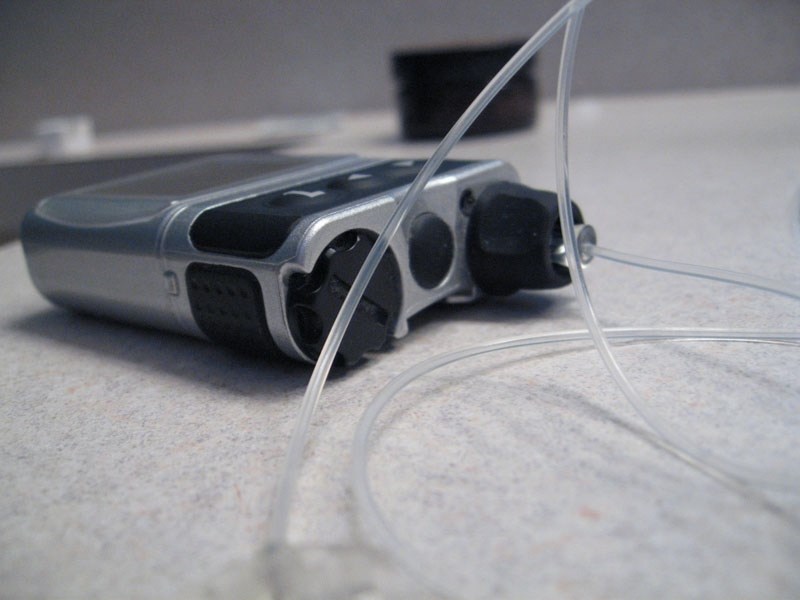Life has gotten a little bit easier for Tom Hamilton-Lane, and it’s thanks to a pager-sized device he carries on his hip.
The Edmonton teen was diagnosed with Type 1 diabetes when he was nine years old. His pancreas’ inability to produce insulin has made it difficult for him to maintain his blood sugar levels without multiple insulin shots per day.
“Having to stop and drink a juice box during a (soccer/hockey) game because I’m low (blood sugar) … it’s been tough,” reflected Hamilton-Lane on how diabetes has affected his love of sports.
Instead of having to inject insulin every time he eats, with the insulin pump the 14-year-old just presses a button on the device for a dose of insulin to be delivered through a plastic tube connected to a small needle under his skin.
Like Hamilton-Lane, more Type 1 diabetics will have the option to use insulin pump therapy since the province started covering the full cost of pumps and diabetic supplies for eligible patients on June 1.
Those already using a pump will have their supplies covered for up to five years and may also be eligible to receive a new pump if they meet clinical criteria. New pump users must be referred to the program by their physician or nurse practitioner and have an assessment done at one of the 11 diabetes insulin pump clinics in the province.
In the Edmonton region, clinics are located at the Stollery Children’s Hospital, Grey Nuns Community Hospital and the Edmonton Clinic.
On average, an insulin pump costs $7,000 and supplies are $300 per month. The cost of the device is a barrier for many who are eligible for the treatment.
For Melissa Martineau’s 11-year-old son Josh, the pump only became a reality last February after he received sponsorship from the Sturgeon Valley Cosmopolitan Club.
“There’s a lot more flexibility with the pump,” said Martineau. “Before it felt like we were playing catch-up a lot, but now it’s more proactive and you can customize it to what you’re doing.”
Martineau explained Josh was on a rigid meal plan for four years prior to the pump. He could only eat at specific times of the day, and in preset quantities such as 50 grams of carbohydrate for breakfast and 25 grams for a snack.
“On the weekends when he was nine or 10, he couldn’t sleep in because he had to get up no later than eight o’clock to check his blood sugar and take his insulin. It was all very time sensitive,” she added.
Hamilton-Lane’s mother Lynn is also no stranger to the strict schedule of diabetes management. She reflected on how difficult meal times could be with her older daughter, diagnosed with Type 1 diabetes at the age of five.
“Sometimes we’d be sitting at the table in tears, saying ‘Margaret, you’ve got to finish this meal because we’ve given you the insulin already.’ You’d be forcing food down her throat, because you had to match the food with the amount of insulin she was taking,” she said. “It was horrible.”
Although insulin pumps have given many patients slight freedom from their disease, the pump isn’t for everyone.
“The insulin pump doesn’t yet think for itself,” said Dr. Richard Lewanczuk, endocrinologist and senior director of primary and community care with Alberta Health Services.
“It doesn’t sense blood sugar levels, it doesn’t know when a person is active or is going to take part in exercise, it doesn’t know what they’ve eaten or about to eat … so it really is incumbent upon the user to have a good understanding of their diabetes.”
Lynn noted both parent and child have to take responsibility when using the pump. A lack of close monitoring can result in pump failure or the delivery of too much insulin. Her son Tom has experienced both and in one instance was hospitalized.
“It’s not a cure. It’s a tool for the right families and the right child.”
Lewanczuk explained that people who are eligible for insulin pump therapy include those with chronic low blood sugar, women who are pregnant or thinking of becoming pregnant and those with demanding lifestyles where traditional methods of insulin injection are problematic, such as working shift work.
Currently there are 13,000 people living with Type 1 diabetes in Alberta, of whom 1,400 use insulin pumps.
The province has allotted $5 million in the 2013 budget for the first year of the program.




